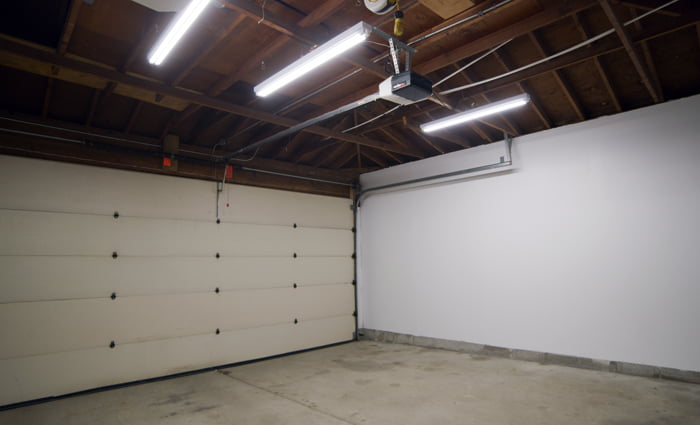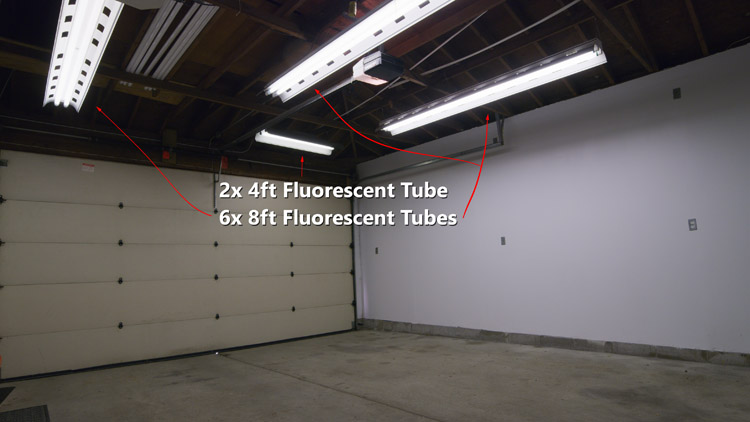Garage Lighting Overview

Used throughout the country for storing vehicles, yard equipment and as general purpose utility work areas, garages are one of the most ubiquitous and common buildings in existence. Usually ranging from small garages in the 500 square foot range all the up to larger units well over 4000 square feet, these facilities often require significant lighting solutions in order to have proper illumination. Traditionally, this was accomplished using fluorescent and incandescent lighting technologies, which provided adequate lumen output for the intended usage of these buildings.
In recent years however, LED technology has come to surpass these traditional lighting options in every conceivable performance metric. Even for home garages and facilities used strictly for recreational or hobby purposes, the benefits of LED lighting are enough to warrant their use. The most readily noticeable benefits include improved energy efficiency and the elimination of regular maintenance requirements. In addition to this, LEDs offer a significantly improved quality of light over traditional lighting tech, especially when compared to fluorescents.
Why LED Garage Lights Are The Best Choice
As mentioned above, there are numerous benefits to using LEDs for garage lighting, regardless of the scale of the garage in question. The first and most obvious benefit of LED lighting is the huge reduction in energy consumption when compared to traditional lighting, especially incandescents. For many garage users, this may not seem like a serious concern however with rising energy costs the savings generated through the use of LEDs can add up to a significant amount. In most situations, energy efficiency is increased by approximately 70% when making the switch, and in some cases higher when upgrading from archaic lighting such as magnetic ballast fluorescent fixtures.


The picture above illustrates a business that used Straits X-Series LED tubes and 4 foot strip lights to replace fluorescent lights in their storage area. Prior to the replacement, the fluorescent lights were noisy and occupying a great deal of ceiling space. The LED T8 tube fixtures greatly reduced the occupied ceiling space, improved the level of lighting, eliminated noise, and provided a more energy efficient and environmentally friendly lighting option.
Another benefit of LED technology for garages is the elimination of regular maintenance and servicing normally associated with traditional lighting options. Historically speaking, most home garages looking for solid light output have used fluorescent lights to provide the best lumen output for the dollar. However, these fixtures often come with hidden long term costs that can make a dent in the savings they generate.
The primary concern here is the finite lifespan of the ballasts required to run fluorescent tubes. These can be quite expensive depending on the particular fixture, and require a bit of mechanical know-how to replace. LED lighting on the other hand does not require any regular maintenance or servicing, as the bulbs are sealed units containing all the components required for their operation. This makes their installation and use straightforward and easy for users of any technical skill level, and saves them from unexpected and hidden expenses. A simple wiping down of the lens from time to time is all that is required for LED fixtures, which may not even be necessary depending on the environmental conditions in which it is operating.
In addition to the economic and convenience benefits of LED fixtures, users of these lights will also enjoy exceptionally good lighting quality that is readily noticeable when compared to traditional lighting tech. Quantified using the Color Rendering Index (CRI), the quality of light produced is measured based on its accuracy in replicating natural sunlight. Ranging on a scale of up to 100, the higher the CRI number the more accurate the illumination will be.
Higher CRI ratings make it easier for individuals to see what they are doing, improving safety by reducing the likelihood of accidents and mistakes. It also produces less strain on the eyes due to them not having to work as hard to see the task at hand. LED lights typically have a CRI rating of at least 80-90, which is a solid 10-20 points higher than traditional lighting, especially fluorescent tubes and CFL bulbs.
Popular Garage Lighting Fixtures
Due to the widely varied shape and size of garages, there are a number of fixtures that are applicable for this application. Something to keep in mind is that every fixture is designed for a specific purpose, and it is important to select the right one for the area in which it is being installed to ensure the best results.
Generally speaking, the two main factors to consider when choosing a garage fixture are the desired lumen output (how much illumination do you need), as well as the beam angle (how wide of an area do you need illuminated). Below is a listing of the most commonly used LED fixtures for garages.
Bob Villa, a home improvement expert with over 30 years’ experience, published an article discussing ways to improve garage lighting. In this article, he advises measuring your garage to determine your true light output needs. Specifically, he states,
“The Illuminating Engineering Society (IES) Lighting Handbook recommends 50 lumens (a measure of light output) per square foot in residential garages and 300 lumens per square foot in workshop areas. A good rule of thumb is to aim for 50 lumens per square foot for ambient lighting, 300 lumens per square foot in areas that require task lighting, and a moderate 75 lumens per square foot for accent lighting.” (Bob Villa, 2021, Basement & Garage 10 Ways to Improve Your Garage Lighting)
Low Bay Fixtures - Designed to be mounted from lower ceiling heights under 20 feet, low bay fixtures are perfect for serious garage users who want excellent lighting output over a wide area for a modest price. Dollar for lumen, these are some of the best performing fixtures on the market for the money.
Strip Lights - Similar to low bay fixtures, strip lights are a slimmer lighter duty fixture intended for smaller areas and cost conscious customers. They produce good lumen outputs with a wide beam angle, and are very popular for use over workbenches and general illumination duties in a garage.
Vapor Tight Fixtures - As one of the most durable and weather resistant light fixtures available for garages, vapor tight fixtures are popular for areas such as garage entryways, overhangs and more. They are sealed from the elements and are resistant to rain, chemical splashes and dust.
Frequently Asked Questions
Q. What are the best lights for a garage?
Choosing the best lights for a garage will depend on several factors, namely, the height of the ceiling from which they will be hung or installed on. Generally speaking, for garage ceilings under 20 feet, we recommend a 4 ft LED Strip Fixture with 2 LED bulbs. For ceilings that are around 20 feet high, we recommend a low bay shop lighting fixture that carries between 4 to 6 LED tubes to ensure adequate illumination from this height. On the other hand, if your garage is going to be exposed to high levels of moisture, you may want to consider investing in a vapor-proof fixture to prevent damage to the lights. You can talk to one of our LED experts for more information.
Q. How many lights for a garage?
This is entirely dependent on the intended use of the garage, as well as other factors such as ceiling height, the square footage of the area to be illuminated. As a general rule of thumb, for a typical homeowner garage, an eight foot span of twin tube strip lights is adequate for a single car space. For garages that may see more intensive use, such as home auto shops or woodworking spaces, higher lumen outputs may be desired for optimal visibility. In situations where a garage is either of an odd shape or design, or for very large installations, working with a lighting expert to design a photometric plan will ensure the best possible lighting solution.
Q. How do you wire shop lights in the garage?
Shop lights are a common type of fixture used for workshops in a garage as well as other commercial and industrial areas. Many fixtures come with two or three prong plugs designed to work in standard 120v outlets that make installation as simple as hanging the light and plugging it in. However, other fixtures are a bit trickier to install, due to them requiring hard wiring in order to connect it to the main power in the garage. For hardwired installations, we always recommend consulting the installation guide and any technical literature that came with your fixtures as this can vary on different models and styles of shop lights.
Q. How do you wire and install garage lights?
The installation of a garage light will depend on the type of fixture. Most garage lights will come with a product specification sheet as well as an installation guide. It’s important to check the specifications and installation guide for safety and to ensure the light is properly installed. Here are some examples of guides we offer for our LED garage lights.
https://commercialledlights.com/pub/media/spec-sheets/SL913TK-Specsheet-3.4.2020.pdf
https://commercialledlights.com/pub/media/spec-sheets/SL913TK-Installation-Guide.pdf

